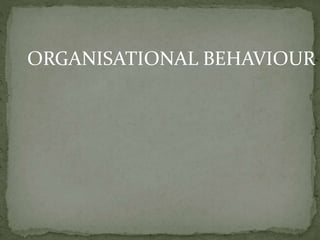
organisational behaviour
- 2. When people join an organization, they bring with them the values and beliefs they have been taught. As individuals come into contact with organizations, they come into contact with dress norms, stories people tell about what goes on, the organization’s formal rules and procedures, its formal codes of behaviour, rituals, tasks, pay systems and jokes only understood by insiders, and so on.
- 3. • In simple words, organisational culture is the distinctive norms, beliefs, principles and ways of behaving that combine to give each organisation its distinct character.
- 4. Organizational Culture is a system of shared meanings held by members. This organizational culture distinguishes the organization from other organizations. Another simple definition: Organizational Culture is a set of shared values that organization members have regarding the functioning and existence of their organization.
- 7. Although in a number of different ways, the process usually involves some version of the following steps: 1. A single person (founder) has an idea for a new enterprise. 2. The founder brings in one or more other key people and creates a core group that shares a common vision with the founder. 3. The founding core group begins to act in concert to create an organization by raising funds, obtaining patents, incorporating, locating space, building, and so on. 4. At this point, others are brought into the organization, and a common history begins to be built.
- 9. • Sometimes an organization determines that its culture has to be changed • For example, the current environmental context has undergone drastic change and either the organization must adapt to these new conditions or it may not survive. • moving to a new culture or changing old cultures can be quite difficult. • Predictable obstacles include entrenched skills, staffs, relationships, roles, and structures that work together to reinforce traditional cultural patterns.
- 10. • Organizational culture is a pattern of basic assumptions that are taught to new personnel as the correct way to perceive, think, and act on a day-to-day basis. • There can be a dominant culture, but also a number of subcultures. • A culture typically is created by a founder or top level manager who forms a core group that shares a common vision. • This group acts in concert to create the cultural values, norms, and climate necessary to carry on this vision.
- 12. Organizational effectiveness is the concept of how effective an organization is in achieving the outcomes the organization intends to produce. OE group does many or all of the following roles : Examines alignment between the areas and improves them Improves trade-offs between reliability, speed and quality in the above areas Strategizes for higher adoption rates in these areas Facilitates/initiates/catalyses capability building : structure, process and people
- 13. Make Use of Human Resources Focus on Education and Growth Keep the Customers in Mind Work on Quality Services or Products Use Technology
- 14. The human resources department of any company plays a key role in the organizational effectiveness of a company. Human resource personnel provide assistance with organizational effectiveness by helping with the design of new business strategies. Since the human resources professionals in a company play an essential role in hiring new employees, they also impact the company goals.
- 15. Organizational leadership requires active measures to work with different groups and individuals. A leader must understand the strengths and weaknesses of different professionals before making a plan of action to improve the effectiveness of the organization. Before making any changes to the company, consider the education of professionals in different areas of the business. Find out about their abilities, skills and strengths. Identify their weaknesses or the areas where specific professionals face difficulties when working as a team.
- 16. Organizational effectiveness only works well when evaluating the needs and interests of the customers. The National Academies Press states that quality management is just as important as the overall efficiency of the company. If a professional does not provide a quality product or service, then customers look for alternatives for their needs and goals. Ask customers to fill in surveys or answer questions about the services provided. Find out what the customers want from the company or the services they find the most valuable for their needs and goals. For businesses with direct interaction with a customer, provide anonymous options for customers to fill out complaints or provide feedback.
- 17. Although clients play a role in the effectiveness of a company, a business must also identify an appropriate level of quality for the products or services provided. The key is focusing on a balance of quality with cost effective solutions. The goal of any business is improving the products without exceeding a set budget or price range. Organizational leadership requires active participation in the decision-making processes. Ask professionals in different areas of the business for advice about improving the products without increasing the costs for materials. Discuss ways to reduce the time required to accomplish specific goals without cutting back on the quality of the final product or service.
- 18. Technological tools play an essential role in the efficiency and effectiveness of a company. Make use of computers, tablets or smartphones to improve the efficiency of the company. Use software or sharing tools to keep different members of a team up-to-date with the state of a project, even when they are not actively working on a specific portion of the project. Work with technological professionals to determine the best ways to protect the business and client information without exceeding a set budget. Use software programs designed specifically to improve efficiency or effectiveness in the office.